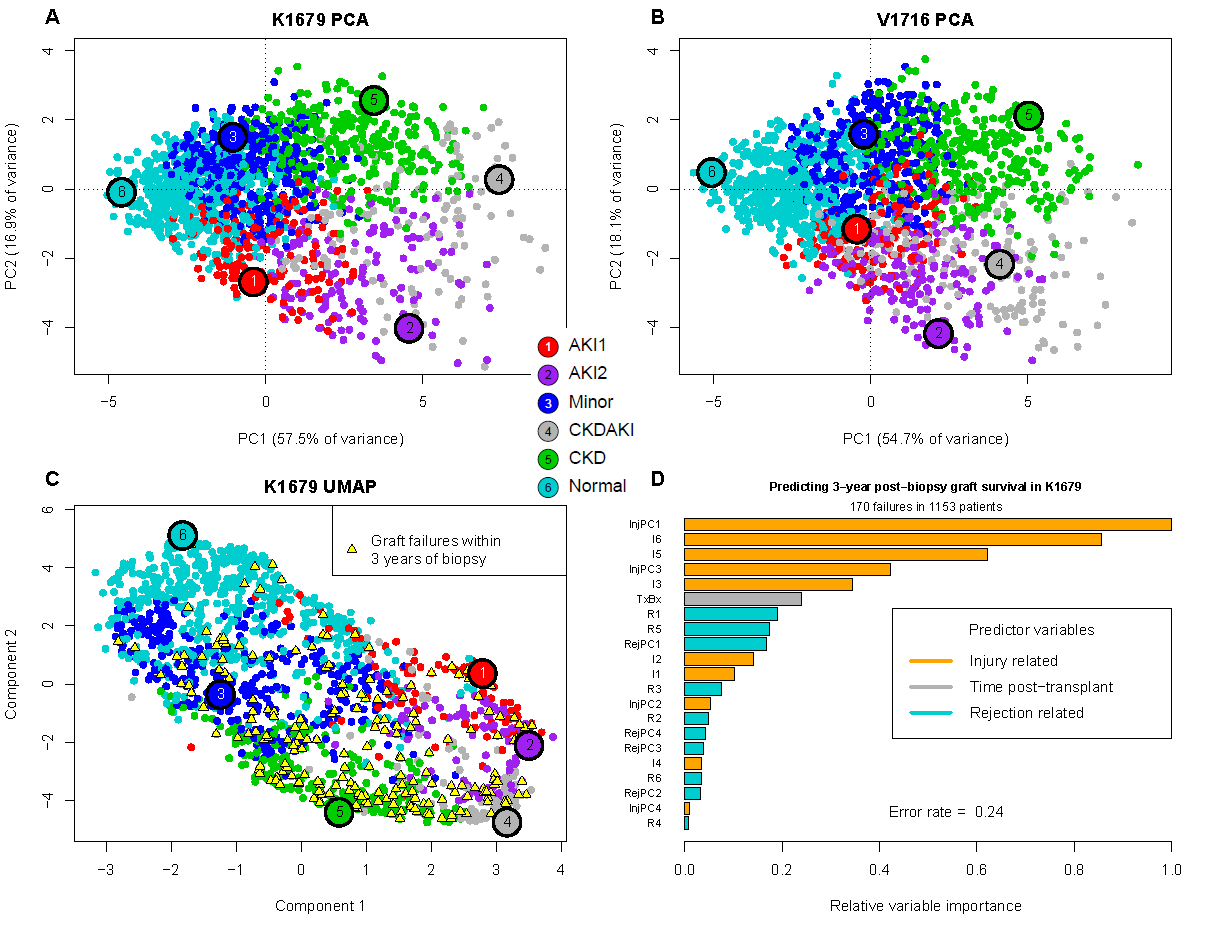Mapping Chronic Kidney Disease (CKD) and Acute Kidney Injury (AKI) in Kidney Transplant Biopsies Reveals Two Classes of Early AKI That Differ in Their Response-to-Wounding
1Alberta Transplant Applied Genomics Centre, Edmonton, AB, Canada, 2Medical University of Vienna, Vienna, Austria, 3Institute for Clinical and Experimental Medicine, Prague, Czech Republic, 4Pomeranian Medical University, Szczecin, Poland, 5Virginia Commonwealth University, Richmond, VA, 6., ., AB, Canada
Meeting: 2021 American Transplant Congress
Abstract number: 173
Keywords: Kidney transplantation, Renal failure, Renal injury, Renal ischemia
Topic: Clinical Science » Kidney » Kidney Complications: Non-Immune Mediated Late Graft Failure
Session Information
Session Name: Kidney Complications
Session Type: Rapid Fire Oral Abstract
Date: Sunday, June 6, 2021
Session Time: 6:00pm-7:00pm
 Presentation Time: 6:00pm-6:05pm
Presentation Time: 6:00pm-6:05pm
Location: Virtual
*Purpose: We recently analyzed injury-induced molecular changes in kidney transplant biopsies using principal component analysis (PCA) (AJT https://doi.org/10.1111/ajt.16374). PC1 reflected all injury, PC2 distinguished early AKI (negative) vs. late CKD (positive). Positive PC3 discovered a new type of injury response: increase in epithelial polarity genes (e.g. PARD3) with minimal inflammation that adversely impacted survival in early transplants. Negative PC3 reflected inflamed injury e.g. TCMR. We explored how these features could be used to classify injury in kidney transplantation.
*Methods: We studied 1526 indication biopsies, using archetypal analysis of injury-induced transcripts to assign injury archetype classes to each biopsy.
*Results: Six injury archetype groups emerged: 1. AKI1; 2. AKI2; 3. Minor injury; 4. CKD (atrophy-fibrosis); 5. CKD+AKI; and 6.Normal (Fig. 1A). The robustness of this classification was validated in a new independent set of 1426 biopsies (Fig. 1B). When all 1526 biopsies were distributed in UMAP and the failures were visualized by triangles, most failures were related to CKD, but AKI1 had relatively common failure (Fig.1C). In random forests comparing rejection (“R”) and injury (“I”) scores, injury PC1, PC3, and archetype scores were the main determinants of three-year survival (Fig.1D).
Donor age was highest in AKI1 and AKI2, and lowest in Minor and Normal, which had the best GFR. AKI and AKI2 kidneys similar rates of delayed graft function (DGF) and low GFR. After removing all rejection, AKI1 had much lower expression of molecular and histologic inflammation than AKI2, low PC1, low expression of injury-induced genes, but high PC3. Among biopsies <6 weeks post-transplant with no rejection, AKI1 kidneys had significantly worse survival than AKI2 (12/46 vs. 3/39, p<0.05), suggesting poor response-to-wounding in AKI1.
*Conclusions: While many kidney transplants fail with CKD, early AKI can also lead to failure, particularly AKI1. Kidneys in the AKI1 state fail to initiate appropriate healing/recovery responses, probably related to the features annotated in injury PC3.
To cite this abstract in AMA style:
Halloran P, Reeve J, Böhmig G, Viklicky O, Myslak M, Gupta G. Mapping Chronic Kidney Disease (CKD) and Acute Kidney Injury (AKI) in Kidney Transplant Biopsies Reveals Two Classes of Early AKI That Differ in Their Response-to-Wounding [abstract]. Am J Transplant. 2021; 21 (suppl 3). https://atcmeetingabstracts.com/abstract/mapping-chronic-kidney-disease-ckd-and-acute-kidney-injury-aki-in-kidney-transplant-biopsies-reveals-two-classes-of-early-aki-that-differ-in-their-response-to-wounding/. Accessed January 1, 2026.« Back to 2021 American Transplant Congress

